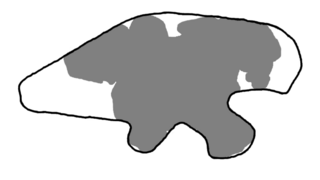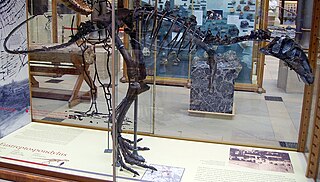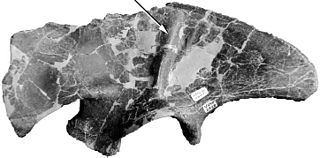
Megalosaurus is an extinct genus of large carnivorous theropod dinosaurs of the Middle Jurassic Epoch of southern England. Although fossils from other areas have been assigned to the genus, the only certain remains of Megalosaurus come from Oxfordshire and date to the late Middle Jurassic.

Coelurosauria is the clade containing all theropod dinosaurs more closely related to birds than to carnosaurs.

Proceratosaurus is a genus of carnivorous theropod dinosaur from the Middle Jurassic (Bathonian) of England. It contains a single species. P. bradleyi, known from a mostly complete skull and lower jaws. Proceratosaurus was a small dinosaur, estimated to measure around 3 m (9.8 ft) in length. Its name refers to how it was originally thought to be an ancestor of Ceratosaurus, due to the partially preserved portion of the crest of Proceratosaurus superficially resembling the small crest of Ceratosaurus. Now, however, it is considered a coelurosaur, specifically a member of the family Proceratosauridae, and amongst the earliest known members of the clade Tyrannosauroidea.

Metriacanthosaurus is a genus of metriacanthosaurid dinosaur from the upper Oxford Clay of England, dating to the Late Jurassic period, about 160 million years ago.

Eustreptospondylus is a genus of megalosaurid theropod dinosaur, from the Oxfordian stage of the Late Jurassic period in southern England, at a time when Europe was a series of scattered islands.

Megalosauridae is a monophyletic family of carnivorous theropod dinosaurs within the group Megalosauroidea. Appearing in the Middle Jurassic, megalosaurids were among the first major radiation of large theropod dinosaurs. They were a relatively primitive group of basal tetanurans containing two main subfamilies, Megalosaurinae and Afrovenatorinae, along with the basal genus Eustreptospondylus, an unresolved taxon which differs from both subfamilies.

Stokesosaurus is a genus of small, carnivorous early tyrannosauroid theropod dinosaurs from the late Jurassic period of Utah, United States.

Megalosauroidea is a superfamily of tetanuran theropod dinosaurs that lived from the Middle Jurassic to the Late Cretaceous period. The group is defined as Megalosaurus bucklandii and all taxa sharing a more recent common ancestor with it than with Allosaurus fragilis or Passer domesticus. Members of the group include Spinosaurus, Megalosaurus, and Torvosaurus. They are possibly paraphyletic in nature with respect to Allosauroidea.

Tyrannosauroidea is a superfamily of coelurosaurian theropod dinosaurs that includes the family Tyrannosauridae as well as more basal relatives. Tyrannosauroids lived on the Laurasian supercontinent beginning in the Jurassic Period. By the end of the Cretaceous Period, tyrannosauroids were the dominant large predators in the Northern Hemisphere, culminating in the gigantic Tyrannosaurus. Fossils of tyrannosauroids have been recovered on what are now the continents of North America, Europe and Asia, with fragmentary remains possibly attributable to tyrannosaurs also known from South America and Australia.

Magnosaurus was a genus of theropod dinosaur from the Middle Jurassic of England. It is based on fragmentary remains and has often been confused with or included in Megalosaurus.
Chuandongocoelurus is a genus of carnivorous tetanuran theropod dinosaur from the Jurassic of China.

The Kimmeridge Clay is a sedimentary deposit of fossiliferous marine clay which is of Late Jurassic to lowermost Cretaceous age and occurs in southern and eastern England and in the North Sea. This rock formation is the major source rock for North Sea oil. The fossil fauna of the Kimmeridge Clay includes turtles, crocodiles, sauropods, plesiosaurs, pliosaurs and ichthyosaurs, as well as a number of invertebrate species.

Streptospondylus is a genus of tetanuran theropod dinosaur known from the Late Jurassic period of France, 161 million years ago. It was a medium-sized predator with an estimated length of 6 meters (19.5 ft) and a weight of 500 kg (1,100 lbs).

Poekilopleuron is a genus of tetanuran dinosaur, which lived during the middle Bathonian of the Jurassic, about 168 to 166 million years ago. The genus has been used under many different spelling variants, although only one, Poekilopleuron, is valid. The type species is P. bucklandii, named after William Buckland, and many junior synonyms of it have also been erected. Little material is currently known, as the holotype was destroyed in World War II, although many casts of the material still exist.
Paleontology or palaeontology is the study of prehistoric life forms on Earth through the examination of plant and animal fossils. This includes the study of body fossils, tracks (ichnites), burrows, cast-off parts, fossilised feces (coprolites), palynomorphs and chemical residues. Because humans have encountered fossils for millennia, paleontology has a long history both before and after becoming formalized as a science. This article records significant discoveries and events related to paleontology that occurred or were published in the year 1824.

Duriavenator is a genus of theropod dinosaur that lived in what is now England during the Middle Jurassic, about 168 million years ago. In 1882, upper and lower jaw bones of a dinosaur were collected near Sherborne in Dorset, and Richard Owen considered the fossils to belong to the species Megalosaurus bucklandii, the first named non-bird dinosaur. By 1964, the specimen was recognised as belonging to a different species, and in 1974 it was described as a new species of Megalosaurus, M. hesperis; the specific name means 'the West' or 'western'. Later researchers questioned whether the species belonged to Megalosaurus, in which many fragmentary theropods from around the world had historically been placed. After examining the taxonomic issues surrounding Megalosaurus, Roger B. J. Benson moved M. hesperis to its own genus in 2008, Duriavenator; this name means "Dorset hunter".
The Taynton Limestone is a geological formation in Oxfordshire in the United Kingdom. It dates to the Middle Jurassic, mid-Bathonian stage. It predominantly consists of ooidal grainstone. The term "Stonesfield Slate" refers to slaty limestone horizons within the formation that during the 18th and 19th centuries were extensively quarried for use in roof tiling within the vicinity of Stonesfield, Oxfordshire. Previously these were thought to belong to the Sharp's Hill Formation, but boreholes and shaft sections suggest that at least three horizons within the Taynton Limestone were quarried for the slate. These horizons are well known for producing a diverse set of fossils including those of plants, insects as well as vertebrates, including some of the earliest known mammals, pterosaurs as well as those of first dinosaur ever described, Megalosaurus.

Sinotyrannus is a genus of large basal tyrannosauroid dinosaur, known from a single incomplete fossil specimen including a partial skull, from the Early Cretaceous Jiufotang Formation of Liaoning, China. Specifically, it is a member of the Proceratosauridae, a family that originated in the Jurassic whose members are known from Europe and Asia. Though it is not significantly younger than primitive tyrannosauroids such as Dilong, it is similar in size to later forms such as Tyrannosaurus. It was much larger than contemporary tyrannosauroids, reaching a total estimated length of 9–10 m (30–33 ft), and was the largest known theropod from the Jiufotang Formation. The type species, S. kazuoensis, was described by Ji et al. in 2009.

Juratyrant is a tyrannosauroid dinosaur genus from the late Jurassic period of England. The genus contains a single species, Juratyrant langhami, which was once classed as a species of Stokesosaurus.































